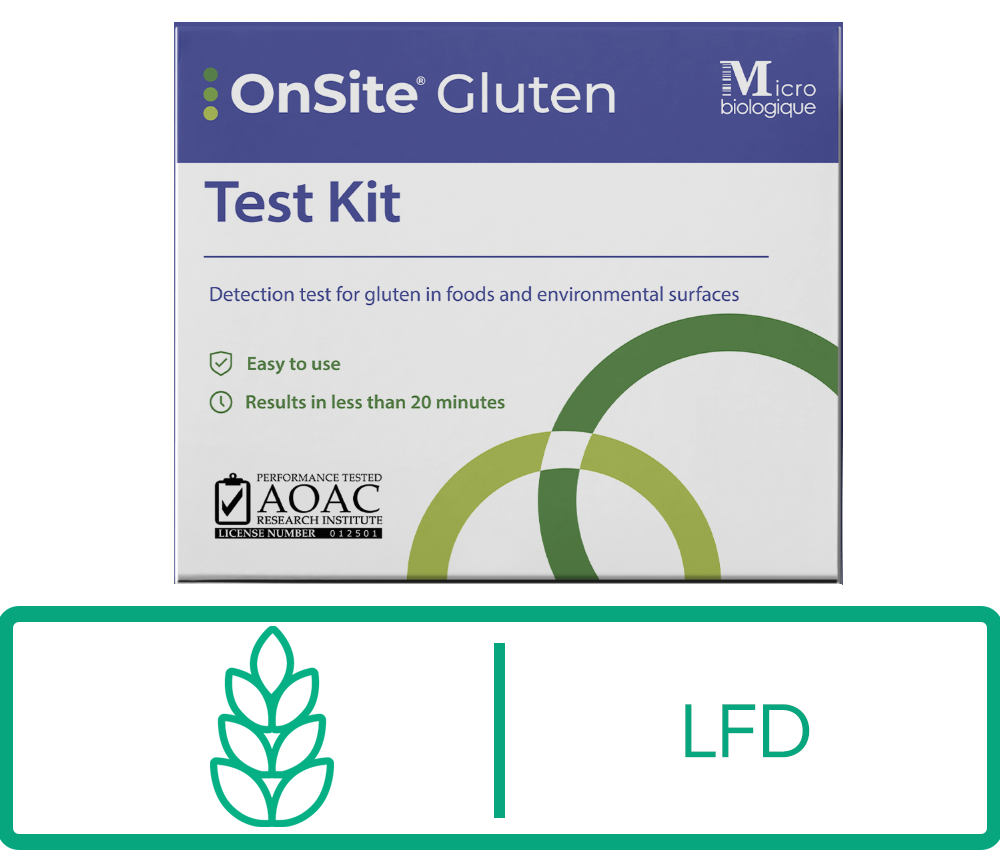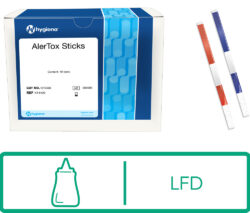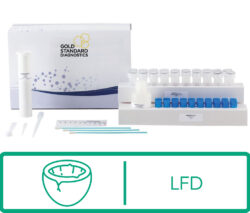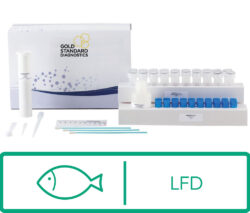OnSite® Gluten
$175.00
Description
OnSite® Gluten
- MB-4444 / PA-44-10
- Rapid detection of Gluten
- 10 tests per kit
- Use for ingredients, cooked foods, rinse water and surfaces
- LOD: 11 μg/100 cm2 for surfaces, adjustable 5, 10, or 20 ppm for productss
- AOAC-PTM certification 012501
The OnSite® Gluten test kit is designed to detect gluten from wheat, barley, and rye in a variety of baked and raw foods and on environmental surfaces.
OnSite® Gluten (MB-4444) has a detection limit of 11 µg/100 cm² gluten on surfaces. The LOD can be variably adjusted to 5, 10, or 20 mg/kg (ppm) gluten in food products, depending on the matrix and the user’s individual needs.
The assay is intended for laboratory and industry use, including within food production facilities, commercial kitchens, contract laboratories, and auditing programs.
No equipment is required.
AOAC-PTM License # 012501 was granted for the matrices of: rice flour, oat flour, spice mix, baked bread, and stainless steel (certificate and validation data available on request).
Optional materials
-
- Blender, grinder, or similar device for homogenizing sample
- Laboratory timer
- Digital scale sensitive to 0.1g for measuring solid samples
- Calibrated laboratory pipette for measuring liquid samples
- Fine-tipped marking-pen
- Lateral flow device reader
- Non-powdered disposable gloves
-
OnSite® Gluten FAQs
Rapid testing is an important component of any food safety plan. Using rapid tests can:
- provide additional reassurance as to the gluten-free status of incoming ingredients
- validate the efficacy of a food production facility’s allergen cleaning protocol
- verify that those cleaning protocols have been undertaken successfully and safely
- confirm the correct (gluten-free) product has been placed in the packaging
OnSite® Gluten test kits are a particularly helpful choice. When it comes to detecting gluten in foods that have been heat-treated or processed with acid, no antibody is more capable than the 2D4 antibody in these tests.Additionally, the adjustable detection limits and simple operating procedures make the kit suitable for food manufacturing facilities and commercial kitchens of every size and shape.OnSite® Gluten is suitable for general use in the food industry. The 2D4 antibody used is effective at detecting barley, wheat, and rye gluten in a wide variety of matrices. 2D4 has comparable sensitivity and specificity to the R5 or G12 antibodies when testing raw ingredients, and increased accuracy when dealing with deamidated gluten.
The kit holds AOAC-PTM Certification for the following matrices: baked bread, rice flour, oat flour, spice mix, and stainless steel.
It has also been validated against a variety of commodities and common food ingredients; there are no known cross-reactive commodities.
Like other rapid antibody-based lateral flow tests, OnSite® Gluten is not designed for fermented or hydrolyzed gluten. It may show reduced sensitivity when testing matrices high in fats or polyphenolic compounds.
The 2D4 antibody in OnSite Gluten has a unique ability to detect not just native gluten, but also deamidated gluten. But what IS deamidated gluten and why does it matter?
Deamidation is a chemical reaction that modifies protein structure. Sometimes it is done intentionally, to improve the functionality of gluten as a food ingredient. For example, wheat gluten is sometimes used as a binder in meat products or a means to increase protein content in foods. Sometimes deamidation is a consequence of the baking or manufacturing process (heat and acid can deamidate gluten).
Lastly, deamidation happens naturally in the body — it is a part of digestion. People who have undergone a celiac blood panel may recall having their levels of deamidated gluten tested.
Studies indicate that deamidated gluten may be more immunotoxic to people with celiac disease. Studies also indicate that this form of gluten is very hard for traditional tests to detect: a 2010 study in the Journal of Cereal Science found that:
Random deamidation decreased the intensities to 13–54% of the intensity obtained for the intact peptides. Deamidation representing the transglutaminase deamidation decreased the intensities to 4–8%. Deamidation of gluten proteins abolished the recognition by omega-gliadin and G12 antibodies and decreased the recognition of R5 by 600 times when analyzed by the sandwich method and 125 times by the competitive method.
Using the OnSite Gluten Test Kit is a simple way to ensure both native and deamidated gluten are correctly monitored.
Test kits are shelf stable (between 2° and 30°C or 36-80°F), however refrigerated storage is suggested to preserve kit shelf life and sensitivity. Please ensure kits are brought to room temperature before using.
Tests are simple to run and no previous knowledge is required.
Complete Instructions for Use are included in each test kit or available in our document library. Please read the full IFU prior to beginning your test.
Our team can also set up a video training call if you prefer; contact us for more details.
No. While an LFD strip reader can be used to ensure consistent, electronic results, there is no way to reliably quantify the gluten from this kit.
In situations where a precise value is required, ELISA analysis should be undertaken by trained personnel.
OnSite® Gluten is designed to react to traces of gluten, and can detect as little as 5ppm gluten. Very high amounts of gluten may result in invalid and/or overloaded tests.
Testing Surfaces for Multiple Tree Nuts?
Consider OnSite Allergen Multiplex Tree Nut. Kit contains everything you need to simultaneously test for 6 common tree nuts (almond, cashew, hazelnut, pecan, pistachio, and walnut) on working surfaces.
Shipping and ordering information
Storage/Shelf Life: Store in original packaging at 2-25 °C (36-77°F). Do not freeze. If using refrigerated storage, allow kit contents to come to room temperature before running tests.
Orders generally ship out Monday-Wednesday, to avoid weekend transit and minimize temperature disruptions.
Orders generally ship via UPS Ground. You will be emailed after purchase if we require additional information and/or shipping fee adjustments.
Want a quote? Have questions? Contact us prior to ordering.
All sales are final. For more information, please see our Terms & Conditions.
Contact us for CoAs, SDS and validation sheets.
Search our Document Library for Manuals, IFUs and more.
Related Products
Related products
-
Hygiena AlerTox® Sticks Mustard (expiring June 2025)
$193.00Original price was: $193.00.$115.80Current price is: $115.80. Add to cart






